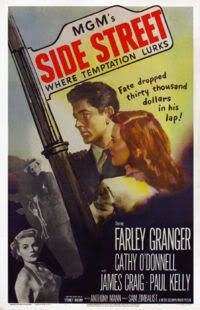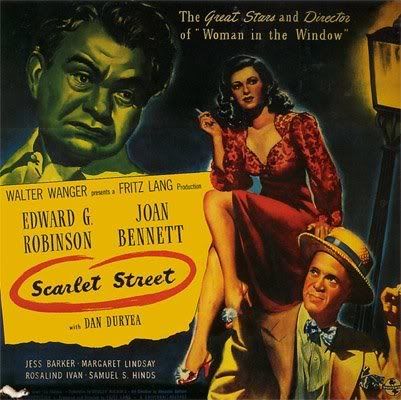NYC Noir Double Feature: Scarlet Street and Side Street

 A few weeks ago, the very first double feature that I saw at the NYC Noir Festival, was "The Woman in the Window" and "Laura." When I was there I overheard some of the other patrons having film conversations, and I heard the title "Scarlet Street" several times. And then at another feature I saw, that title was said yet again. So I went online to research the film, and saw that 'Scarlet Street' was indeed playing at Film Forum. I did not have it on my original schedule, so I added it after seeing the talent involved. In addition to it being called "one of the best film noirs" by other patrons at the theatre, it reunited three of the lead actors from "The Woman in the Window," which I gave four stars-Edward G. Robinson, the beautiful Joan Bennett, and Dan Duryea, who played the villain in that film. And it also brought them back together with the great Fritz Lang. But it did not bring back the writer of "The Woman in the Window," Nunnally Johnson, and it was partially the screenplay that made that film so great. I was wondering why the theatre did not play "The Woman in the Window" as a double bill with "Scarlet Street," because although 'Woman" shares a strong theme with the film presented at that double feature-"Laura"-this is the follow up to "Woman" and there should have at least been a double bill with it. Or better yet, a triple bill with all three of them-the commonality being the woes of obsession and the paths that it will lead you down.
A few weeks ago, the very first double feature that I saw at the NYC Noir Festival, was "The Woman in the Window" and "Laura." When I was there I overheard some of the other patrons having film conversations, and I heard the title "Scarlet Street" several times. And then at another feature I saw, that title was said yet again. So I went online to research the film, and saw that 'Scarlet Street' was indeed playing at Film Forum. I did not have it on my original schedule, so I added it after seeing the talent involved. In addition to it being called "one of the best film noirs" by other patrons at the theatre, it reunited three of the lead actors from "The Woman in the Window," which I gave four stars-Edward G. Robinson, the beautiful Joan Bennett, and Dan Duryea, who played the villain in that film. And it also brought them back together with the great Fritz Lang. But it did not bring back the writer of "The Woman in the Window," Nunnally Johnson, and it was partially the screenplay that made that film so great. I was wondering why the theatre did not play "The Woman in the Window" as a double bill with "Scarlet Street," because although 'Woman" shares a strong theme with the film presented at that double feature-"Laura"-this is the follow up to "Woman" and there should have at least been a double bill with it. Or better yet, a triple bill with all three of them-the commonality being the woes of obsession and the paths that it will lead you down.Scarlet Street (1945) ***
103 Minutes
Directed by Fritz Lang
Edward G. Robinson stars yet again as a lonely man, named Chris-more so than "Woman" because in this film he doesn't even like his wife a little bit, and only married her because he was so lonely. He is a would be painter that ended up becoming a great bank cashier, and on his way home one night he finds a man beating up on a woman-Kitty (played by Joan Bennett, who never looks better when Lang is shooting her. She was more-so a knockout in "The Woman in the Window" and "Scarlet Street" than in her other films that I have seen.) Chris hits the man and by the time he comes back with the cops, he is gone. The two flee back to her place, where they begin to talk. Chris is instantly attracted to her, and she gets the idea that he is a famous painter. Her boyfriend, Johnny-who is also the man that was beating her up-begin to scheme to get something out of the old man, as they both have the idea that he is richer than he is. And she strings him along, the con eventually going into deeper territories than either of them ever imagined.
The best part's of "Scarlet Street" are the acting and the directing. Robinson and Bennett may have been one of the best odd couples in film history, because the two of them clearly don't belong together, and both "Woman" and "Scarlet" just highlight this difference. Their relationship is very different in this, and it's clear that they were trying to make a film the opposite. In the other she seemed interested in him, genuinely-almost as lonely as he is. In "Scarlet Street' everything she says to him is all a lie. In addition, Dan Duryea does play a bad guy in this film as well, but not to the extreme as in "Woman." Lang's direction is great as usual, and I liked the touch of having a portrait of a detective in Robinson's house-a portrait of his wife's first dead husband-instead of actually having a real detective investigate. I thought it was a minor comical touch. And there are several fun little throwbacks to "The Woman in the Window," including an art subplot where Joan Bennett once again becomes a painted woman in a gallery window.
My problem with the film was the screenplay, which just seemed too stuffed with subplots and layered with more and more twists. It became a bit tedious as opposed to "The Woman in the Window" which took a simple concept and made strong fun tension with it. By the last fifteen minutes-which throw in a murder to add on to everything else-I had had enough, even though I was greatly satisfied with the bleak and grim ending that seemed to go against all ideas of censorship of happy endings that I expect from these old movies. I really did not the very last scene and shot, even if some of the things before it seemed a bit much. So I recommend not a double bill, but a triple bill-combine the two Lang's with "Laura" to get a triple feature of an intense study of obsession and what women out of reach could do to men-and the strong consequences. It's very interesting how all of these films collide ideas.
---------------------------------------------------------------------------------
Side Street (1950) **1/2
83 Minutes
Directed by Anthony Mann
In the end, "Side Street" is just there in film history-there is nothing really memorable about it or anything to rave about. To sum it up in a word: mediocre. This is Film Noir Basic-the good guy ends up getting involved in something way over his head, all because of a woman. And it describes his downfall up to the end-which usually works out upbeat. I liked it in the way that you'll like any type of film that you've seen structured in this way before. Farley Granger plays Joe, a man living in New York City-middle class, and always dreaming of giving his future wife-Ellen-more than he can. So he steals some money from some people that get angry and begin to hunt him down. And he leaves the money with a bartender friend, who is found by these men and killed. Now Joe doesn't know where the money is, but those men do not care, and the cat and mouse chase begins.
There are some neat scenes in "Side Street"-including a car chase at the ending-but everything is so-so from the very start. The acting isn't anything special, perhaps with the exception of Jean Hagen, who plays a sultry and sexy nightclub singer that Joe is forced to find at one point. In the end this is a more an interesting study of what happens with multiple classes merge in the same city. Eventually there will be temptation to want more, but the moral is to press on and always try to succeed with what you have. The film is bookended with narration, and both narrations were the best part in the whole film. Joe learns a lesson in the end, as did I, and on that aspect "Side Street" is a success. When it comes to telling a decent story, it did not catch me, and it's nothing special.
For more information on the NYC Noir Festival, visit the Official Film Forum Website!

0 Comments:
Post a Comment
Subscribe to Post Comments [Atom]
<< Home